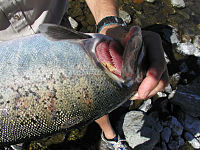Columnaris Disease
|
| Flavobacterium columnare | |
|---|---|
| Kingdom | Bacteria |
| Phylum | Bacteroidetes |
| Class | Flavobacteria |
| Order | Flavobacteriales |
| Family | Flavobacteriaceae |
| Genus | Flavobacterium |
| Species | F. columnare |
Caused by: Flavobacterium columnare
Previously Known As: Bacillus columnaris — Chondrococcus columnaris — Cytophaga columnaris — Flexibacter columnaris
Introduction
F. columnare is the gram negative, aerobic, rod shaped bacterium responsible for Columnaris disease in fish.[1]
This disease is not zoonotic.
Distribution
Worldwide. The organism is ubiquitous in aquatic freshwater environments.
Signalment
A huge range of fish hosts can be infected including the trout and salmon family, eels, goldfish, Siamese fighting fish, catfish and bass species. Cultured fish, free ranging fish and aquarium fish can all be affected although cultured fish reared in ponds or raceways are the primary concern. It is not recognised as a problem in wild fish populations.
Columnaris disease can occur in cool and warm water fish, but is most prevalent in air temperatures above 12-14⁰C.
Skin abrasions, husbandry stressors such as overcrowding, poor nutrition, underlying diseases and warm water all increase the risk and prevalence of infection.
Clinical Signs
The skin and fins of infected fish may darken or lighten in colour and circular yellow-grey opalescent necrotic patches or erosions are visible on the skin and/or gills. The gill filaments may have whitish spots on their tips. Mucus often also accumulates on the gills, head and dorsal regions. In advanced disease, erythematous spots are widespread. Inappetance and lethargy are common, as are mortalities. Gill lesions cause respiratory distress and its associated clinical signs – gulping air, sinking, erratic behaviour etc. Morbidity can approach 100% and mortalities are highest in younger fish.
In catfish specifically, severe tissue necrosis develops into “saddleback” lesions on the dorsum.
Diagnosis
Bacteria can be isolated from gills, skin and sometimes internal organs, particularly the kidneys.
The pathogen can then be cultured on reduced nutrient agar, such as cytophaga agar. Culture is often more successful by inhibiting contaminant growth on the agar by adding neomycin or polymyxin B. The bacterium will also grow at 37⁰C which will inhibit most other pathogens of interest so can be used as an inhibitory factor. Colonies are small, 3-4mm in diameter and grow within 24h. They are characteristically and uniquely rhizoid in structure and pale yellow in colour, and adhere to the agar surface. They stain pink when exposed to potassium hydroxide. This pathognomic culture finding can be used as a definitive diagnosis for columnaris disease, especially where clinical signs are present.
Phenotypic tests can then be carried out on colonies if in any doubt.
Microscopy of wet tissue mounts from gill or skin scrapings often reveals haystacks or columns of bacteria. Cells can also form chains, giving the impression of a longer, single prokaryotic cell.
Treatment
Potassium permanganate, copper sulphate and hydrogen peroxide can be applied externally to adult fish and fry but can be toxic at high concentrations.
Terramycin can also be added to feed for adults, fry or broodstock, but resistance is emerging.
Vaccines can also be given in the face of an outbreak.
Control
A vaccine is available against F. columnare, consisting of formalin killed whole cells.
| Columnaris Disease Learning Resources | |
|---|---|
 Test your knowledge using flashcard type questions |
Columnaris Disease Flashcards |
References
- ↑ Bernardet, J. F., Segers, P., Vancanneyt, M., Berthe, F., Kersters, K., Vandamme, P (1996) Cutting a gordian knot: emended classification and description of the genus Flavobacterium, emended description of the family Flavobacteriaceae, and proposal of Flavobacterium hydatis nom. nov. (basonym, Cytophaga aquatilis Strohl and Tait 1978). International Journal of Systematic Bacteriology, 46:128-148
Starliper, C.E. and Schill, W.B. 2011. Flavobacterial Diseases: Coldwater Disease, Columnaris Disease, and Bacterial Gill Diseases. In: Fish Diseases and Disorders Volume 3: Viral, Bacterial and Fungal Infections, 2nd. Edition (eds. P.T.K. Woo and D.W. Bruno), CABI, Wallingford, UK, pp. 606-631

|
This article was originally sourced from The Animal Health & Production Compendium (AHPC) published online by CABI during the OVAL Project. The datasheet was accessed on 11 July 2011. |
| This article has been expert reviewed by Prof Patrick Woo MSc PhD Date reviewed: 24 August 2011 |
Error in widget FBRecommend: unable to write file /var/www/wikivet.net/extensions/Widgets/compiled_templates/wrt6621fdac40ead0_50914153 Error in widget google+: unable to write file /var/www/wikivet.net/extensions/Widgets/compiled_templates/wrt6621fdac463905_64896451 Error in widget TwitterTweet: unable to write file /var/www/wikivet.net/extensions/Widgets/compiled_templates/wrt6621fdac49b5f4_67531397
|
| WikiVet® Introduction - Help WikiVet - Report a Problem |

